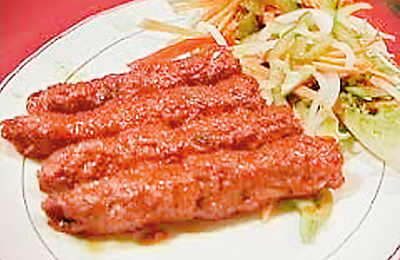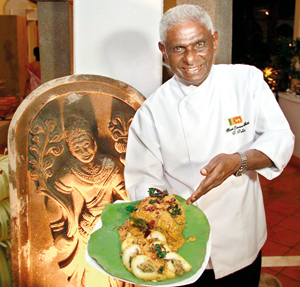The Indian summer
Navayuga:
Launched in Chennai a year ago and in Colombo a month back, the façade of Navayuga is ornate, with spectacularly carved archways, doorways and pillars from a heritage Chettinad mansion. Stark interiors provide a contrast to the elaborate exterior and western classical music is inconsonant too. Brilliantly lit panels flow down the walls and feature prints of North Indian Moghul carpets overlooking tables embedded with a mat of South Indian exotica, suggesting that North and South Indian cuisines are served. Twig lamps illuminate the menu.
The restaurant is a Chennai chain, so I’m insistent on Southern fare, despite Manager Jagan Mohan’s urges that they also have a North Indian chef. My obstinacy is rewarded with Andhra drumstick and Tamil rasams, both banal and inundated with oil and salt. But the Cauliflower 65, an incredible spiced yoghurt marinade, deep-fried, incredibly traces no oil trails on the dish. Next, purportedly “Chettinad” potatoes, not distasteful but an adaptation, Mr Mohan admits. He implores we proceed with his recommendations, but no… And so I’m brought ulundu vadais of little merit. Dosas slack, spices lack, chutneys and sambar of the pedestrian smack. A plate of idli at Rs 200 seems impertinent, especially when callously textured unlike those delicate clouds that float on your plate at Sri Suryas.
Canny Mr Mohan supplements chapathis, methi parahtas, malabar parathas and paneer makhani. The melt-in-your-mouth whole-wheat chapathis and methi parathas are without doubt the best I’ve had in town. Mr Mohan assures the South Indian will equal the North Indian next time.
Next time round, the South Indian starters are a sensation: avatipoo (banana flower) vadai and spice-tickled, perfectly-textured karunia (yam) chops. Paruppu vadai sequined in aniseed with studs of gravelly dhal must be Colombo’s finest. Chutneys, coconut and tomato, have dramatically, even miraculously, metamorphosed since my preliminary visit. I’m then presented the South Indian chef John Kerthi, apparently absent the first time. But before I can clamour for dosas and idlis, the North Indian Chef Asharam from Utharkand manifests: today’s feast is his prerogative.

Mutton sheek kebab at Navayuga
And his rajma, cooked just right, is a delicate interplay of masalas. Magnificent. Kadai vegetable impresses. Malai kofta, though sweet, is richly cashewed. However, the astounding breads require no accompaniments. So flavoursome, and ever so lithely textured, are arguably Colombo’s best tandoori roti, lachcha paraha and naan. Amazed at Chef Asharam’s breads so slim they hardly exist I query and learn that despite the constraints of being cost-effective in inflated Colombo, chef absolutely refused to work with substitute ingredients. Unlike other Indian chefs in conflict with local F&B managers, Chef Asharam is allowed premium Indian wheat flour which he has kneaded for almost an hour to attain those sublime textures.
To finish: until kulfis launch, gajar halwa gleams with cashews, almonds, raisins whilst clove-specked coconut payasam, if sweet, is authentic. However, my treat is marred by British tourists ululating, “Amazing, amazing!” with every single bite.
A conveniently located, less expensive alternative to certain over-priced, uninspiring neighbourhood Indian stand-alones, Navayuga indeed heralds a new era in Indian dining.
Navaratna:
India is famed for the Big B. You think Amitabh Bachchan. We think the biriyani! And Navaratna becomes bounteous with biriyani from July 13-29. Chef Chauhan’s potpourri of experiences around India expresses itself in 12 distinct potted extravagances simmering with regional flavours and fragrances. “No two biriyanis are similar,” Chef establishes emphatically.
Had I anticipated uniformity and monotony -the imagination all in fancy names of dishes tasting all the same- then this biriyani bonanza distinguishes itself. Unique too is the assemblage of six vegetarian biriyanis. They aren’t just veg alterations of mutton/lamb/chicken. This is a rare, well-conceived, well-crafted promotion and not another instance where the marketing department has out-laboured the chefs.
Furthermore, Chef Chauhan garnishes his creations with a narrative, elaborating provincial provenances. He begins that rice-meat mélanges began in Persia and Afghanistan.
But the biriyani is indigenous to India. Indeed, the biriyani went vegetarian to endear itself to Hindus and evolved amongst meatier Muslims too: as Muslim families expanded and finances constricted, biriyanis espoused cheaper vegetables and lentils. And consequently acquired state-specific nuances. Besides, if the biriyani evokes Nawabi or Nizami grandeur, then it permeated less lofty social strata once meaner ingredients partook. Thus, the biriyani undulates from regal to rustic.
Chef Chauhan also quips about the biriyani’s “modernisation.” If traditionally the biriyani is sealed in a “dum” clay pot seated between four coals, which imparts a smoky flavour, then convenience now demands the biriyani be oven-baked, at the relinquishment of the coal-fired flavour.
But Chef Chauhan, whose grandfather inaugurated the celebrated Bukhara restaurants the Clintons adore, delightfully elaborates repudiated a family army tradition to take not marching orders but tall orders, piled up like biriyani.
Pile tawny Delhi dhingri mushroom biriyani booming with garam masala. Doesn’t sound terribly exciting, but is the most haunting. More unusual is subtle kathal baby jak biriyani from Uttar Pradesh. Jak is oft considered unsophisticated, an incongruity in lavish biriyanis. But, fascinatingly, bumpkin vegetables refine themselves into a delicacy laced in luxurious green cardamom and cumin.
The celebrity biriyani is the royal Nizami special from Hyderabad. Savour subz zafrrani mellifluous with saffron, mace, aromatic herbs and redolent cooling agent kewda, not quite translatable into English.
Our Punjabi chef’s Punjabi Chharra aloo, basmati enclosing globes of spiced baby potatoes and spherical coriander seeds, lingers longly on the palate. Chef Chauhan rechristens a Rajasthani biriyani incorporating rods of gram flour gatta and chickpeas “Bela Moti,” bela being rolling-pin, “And don’t chickpeas resemble pearls (moti)?” Chef Chauhan beams at his similes.
There’s a biriyani “dedicated to boiled egg lovers,” self-professedly chef Chauhan himself, who also avows a passion for soya. Hence, the Soya & Almond Biriyani purportedly from Kashmir. I hadn’t thought soya especially Kashmiri, but this biriyani athrob with swollen almonds and mild herbs is quirky. Chef insists it’s a Kashmiri Pandit dish. He also insists the saffron and lagoon prawn biriyani is Pan-Indian.
The menu declares preparations are of “finest basmati,” although the basmati isn’t Indian…. Whole spices and saffron seem exiguous, but apparently finely ground. Yet one would rather the biriyanis didn’t grease-stain plates. But with new mango kulfi, the best I’ve had, Chef Chauhan extricates himself admirably from a sticky situation.
Navaratna perennially bulges like a dum-pot with regulars. Those who’ve pre-judged Colombo’s premier Indian restaurant forbiddingly priced avail of biriyanis from Rs.890 accompanied by raitas and salads that can feed two, even three (considerably cheaper than Rs 750 sandwiches at certain cafés). Portions portly enough to leave you pot-bellied!
Spices:
Chef Pawan Singh may be persuaded to fabricate Bengali mishti dahi, a low-calorie yoghurt dessert interspersed with nuts and saffron. Take-away only. By special order only. Otherwise during Saturday Indian Night try cardamom-infused gulab jamun- perhaps Colombo’s only ones worth having.
comments powered by Disqus

















